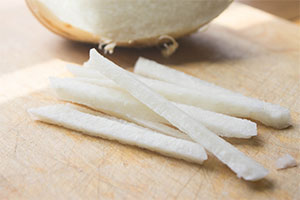Fun Facts:
Jicama is pronounced HEE-kuh-muh.
Jicama is known by many other names including Mexican potato or turnip, yam bean, and sweet turnip.
Background:
Jicama is a member of the botanical family Fabaceae which is more commonly known as the legume or bean family and contains many different plant foods:
- soybean
- pea
- chickpea
- kidney beans
- lima beans
- lentils
- and peanuts, among many others
Jicama is an edible root vegetable. All other parts of the plant including the leaves and seeds are toxic and should not be eaten.
Jicama has a crunchy, crisp texture like an apple or pear. Unlike an apple, jicama flesh doesn’t brown when exposed to air.
Nutrition:
Jicama is an excellent source of fiber and vitamin C.
- Fiber supports the digestive system and assists you to feel fuller faster helping to control weight.
- Vitamin C helps to heal wounds and aids in iron absorption.
- Jicama also contains the prebiotic inulin, which is beneficial for gut health.
How to purchase, prepare and store jicama:
- Purchase jicama at specialty Latino grocers or larger supermarkets year round.
- Choose small to medium jicamas heavy for their size. These will be sweeter and less starchy than large jicamas.
- The outer skin is brown and should be free from blemishes or soft spots.
- To prepare the jicama, wash the outer skin well (you may want to use a vegetable scrubber to remove any potential dirt).
- Always peel using a knife or vegetable peeler.
- Cut or shred as recommended per your recipe.
- Jicama can be eaten raw or cooked.
- Roast, sauté, boil and mash, or add to a salad or soup.
Nutrition Facts
½ cup sliced raw jicama
- Calories: 22.8
- Protein: 0.432 g
- Fat: 0.054 g
- Carbohydrate: 5.3 g
- Fiber: 2.94 g
- Calcium: 7.2 mg
- Iron: 0.36 mg
- Magnesium: 7.2 mg
- Phosphorus: 10.8 mg
- Folate: 7.2 µg
- Vitamin A: 0.6 µg
Via fdc.nal.usda.gov
Recipes
Request an Appointment